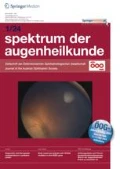Zusammenfassung
Das Projekt SEE-KID (Software Engineering Environment for Knowledge-based Interactive Eye Motility Diagnostics), welches an der Forschungsabteilung des Studiengangs Software-Engineering für Medizin (FORTE) in der Fachhochschule Hagenberg seit Jänner 2000 durchgeführt wird, verbindet die Aspekte der biomechanischen Modellierung mit Methoden der modernen Softwareentwicklung. Dieses System wird bereits als Lehr- und Lernsystem zur Aus- und Weiterbildung von Fachärzten und Orthoptisten in Österreich und Deutschland und in den USA eingesetzt. Komplexe mathematische Modelle für die Motilität des menschlichen Auges und deren grafische, dreidimensionale Visualisierung bilden die Basis für die Umsetzung eines interaktiven Systems. Das Ergebnis ist ein biomechanisches Augenmodell, welches wiederum in Forschung und Lehre Anwendung findet. Das systematische Studium solcher Modelle und deren Anwendung ergibt neue Erkenntnisse, die wiederum in das Modell integriert, eine vertiefende Forschung ermöglichen, und gleichzeitig das Modell verfeinern. Mit der Computersimulation SEE-KID kann der Strabologe präoperativ eine Augenmotilitätsstörung simulieren, durch interaktives „virtuelles Operieren“ den Ablauf der späteren Operation planen und korrigieren und damit die Effizienz des Eingriffes abschätzen.
Summary
The research project SEE-KID (Software Engineering Environment for Knowledge-based Interactive Eye Motility Diagnostics), carried out at the research department for Software Engineering for Medicine of the Polytechnic University of Upper Austria since January 2000, tries to incorporate biomechanical modeling and methods in the field of Software Engineering. The resulting computer system is currently applied as online teaching system to aid orthoptics and physicians, but also students in the field of strabology in Europe and the USA. Complex mathematical models of the motility of the human eye, together with a graphical 3D representation form the basis for the design and implementation of an interactive simulation system. This system represents a biomechanic model, which in turn can be applied in research and teaching, giving additional insight into the field of eye motility diagnostics and treatment.
Using the presented computer simulation system SEEKID, a physician is enabled to preoperatively simulate eye motility disorders and predict possible outcomes of surgical treatments by interactively simulating eye muscle surgeries. Due to these possibilities, a physician should be able to better evaluate the correcting efficiency of possible surgical processes for different pathological cases.
Literatur
Boeder P (1962) Co-operative action of extra-ocular muscles. Br J Ophthalmol 46: 397
Buchberger M (2001) Ein dynamisches, volumserhaltendes 3D-Deformationsmodell von extraokulären Muskeln, basierend auf der Analyse von MRI-Daten. Proc. 1. Jahrestagung der Österreichischen Wissenschaftlichen Gesellschaft für Telemedizin, pp 37, Innsbruck, Österreich
Buchberger M, Mayr H (2000) SEE-KID: Software Engineering Environment for Knowledge-based Interactive Eye Motility Diagnostics. Proc. Int. Symposium on Telemedicine, Gothenburg, Sweden
Demer JL, Miller JM (1995) Evidence for Fibromuscular Pulleys of the Recti Extraocular Muscles. Invest Ophthalmol 36 (6): 1125–1136
Gibas C, Jambeck P (2001) Developing Bioinformatics Computer Skills. O’Reilly & Associates, USA, pp. 30, ISBN 1-56592-664-1
Günther S (1986) Die modellmäßige Beschreibung der Augenmuskelwirkung. Diplomarbeit am Fachbereich Physik der Universität Hamburg, Deutschland
Haslwanter T (1995) Mathematics of three-dimensional eye rotations. Vision Res 35 (12): 1727–1739
Kaufmann H (1986) Strabismus. Enke Verlag, Stuttgart, Deutschland, ISBN 3-432-95391-7
Krewson WE (1950) The action of the extraocular muscles. Trans Am Ophthalmol Soc 48: 443–486
Kusel R, Haase W (1977) Versuch einer mathematischen Darstellung der Augenmuskelwirkung. Deutsche Ophthalmologische Gesellschaft 45: 453
Miller JM, Robinson DA (1984) A Model of the Mechanics of Binocular Alignment. Comput Biomed Res 17 (12): 436–470
Priglinger S, Hametner H (1994) Operative Methoden zur Behandlung des schwankenden Schielwinkels. Mathematische Zusammenhänge — Computergestützte Operationsplanung. Spektrum Augenheilkd 8 (4): 162–175
Priglinger S, Hametner H, Haslwanter T (2001) Functional topography as a guideline for differential diagnosis of vertical eye movement disorders and oblique muscle surgery. Spektrum Augenheilkd 15 (1): 16–26
Robinson DA (1969) Mechanical components of human eye movements. J Appl Physiol 26 (5): 548–553
Robinson DA (1975) A quantitative analysis of extraocular muscle cooperation and squint. Invest Ophthalmol 14: 801
Volkmann AW (1869) Zur Mechanik der Augenmuskeln, Ber. Verh. Sächsische Gesellschaft der Wissenschaften, 21–28
Zajac FE (1989) Muscle and Tendon: Properties, models, scaling and application to biomechanics an motor control. Cir Rev Biomed Engng 17: 359–411
Author information
Authors and Affiliations
Corresponding author
Rights and permissions
About this article
Cite this article
Buchberger, M. Ein biomechanisches Modell der Augenmotilität. Spektrum Augenheilkd 16, 176–182 (2002). https://doi.org/10.1007/BF03164294
Published:
Issue Date:
DOI: https://doi.org/10.1007/BF03164294

